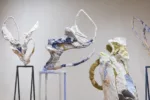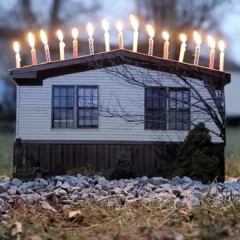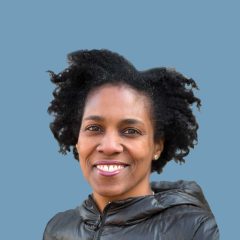City dwellers face unpredictable environments. Whether descending into subterranean tunnels or ascending into office towers; biking merrily along while inhaling large quantities of carbon monoxide or walking through the stench of human waste that wafts from Center City’s overtaxed sewage system, a day in the city is a moment-by-moment negotiation between the inanimate and animate, the accidental and intentional, the old and new. In a dialogue between the works of three artists all concerned with architecture and city spaces, Urban Environments at Grizzly Grizzly shows pieces that portray the artists’ subjective conceptions of the urban world.
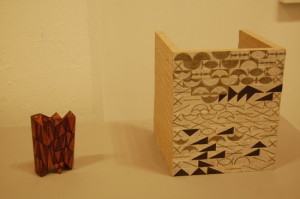
A collaboration between two artists who have worked together for over eight years through long-distance discussion and planning (Tom Lauerman in Philly, Fabio J. Fernandez in Boston), “Sculptures in Love with Architecture” is a collection of finely-crafted, small-scale pieces, most of them three to five inches in any dimension. Each of these small investigations poses a question about space, gently probing into the realms of recognizable design and abstract geometry. The objects are discrete conglomerations of matter, yet seem to indicate joint participation in an unseen, interconnected system.
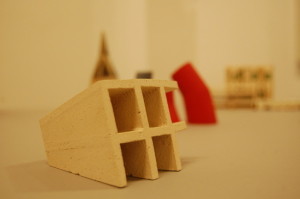
An earlier incarnation of this ongoing project was exhibited at Loyola University in Chicago in 2012, displaying the same essential themes which remain clearly at the forefront of the artists’ minds: drawing, design, structure and architecture, both ancient and modern. At Grizzly Grizzly, the newer additions to the collection are made of repurposed wood (clementine crates, which remain recognizable even after they have been reassembled and rubbed with ink pigment) and included alongside earlier ceramic and stoneware pieces.
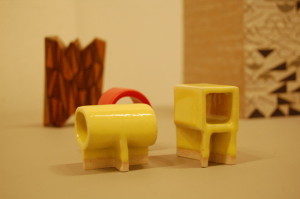
In Grizzly Grizzly’s small gallery, the sculptures are arranged on a simple board balanced over two saw horses, high enough to provide a slightly aerial view, but low enough to require squatting for a good look– giving viewers the perception of peering into a miniature model of a strange, sculptural village, while the tiny architectural elements seems as if they are intended to be picked up and handled, like tools to decipher the space they inhabit.
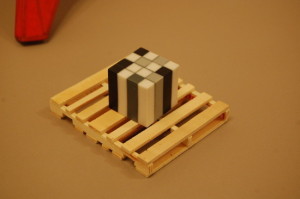
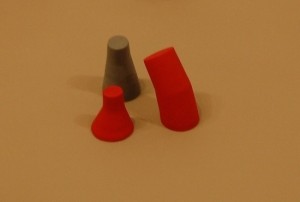
Fernandez’s Three Cones, Interrupted, three brightly-colored cylindrical objects slightly inclined towards one another as if in conversation, create an insular, exclusive little cluster on the table’s surface, and also suggest the termination of the extended movement of objects like heating ducts or pillars, which they resemble.
Two bodies of work that suggest rather than depict
When seen in conjunction with the oozing, elliptical and somewhat anthropomorphic shapes in the drawings of Colin Keefe with which they share space, both drawn and sculpted shape are called into question. Is one an interior building block, providing stability for its surrounding parts? Where do they begin and end within their given space?
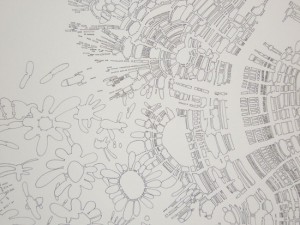
Colin Keefe’s drawings in this show are all recent works, except one (Mycelia). I wrote a piece earlier this month about the development of his current studio practice and the ostensible narrative of his pieces. His works, which meld organic and inorganic shape-patterns in drawings that resemble city maps, conceptually strike a balance between separate but mutually dependent phenomena. Keefe blends maps of urban landscapes, seen from above, with the structure of a biological cell and its various organelles, to indicate a process of transformation over time, even as the image itself remains static. The drawings portray a cosmology akin to that described by physicist James Jeans: “The universe looks more and more like a great thought rather than a great machine.”
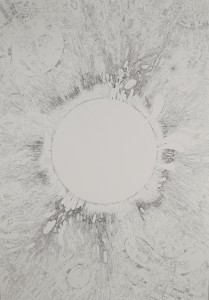
Keefe’s drawings are made up exclusively of black lines delineating white shapes, primarily of small boxes and organic cellular circles and blobs. The drawings come into vivid life when one begins to see the lines as designating the border between an interior and exterior of equally stark blankness. The power of blankness in Keefe’s work is almost overpowering in his recent piece, Heliotrope, which is dominated by a large blank circle, slowly growing plant-like tendrils out into rest of the composition.
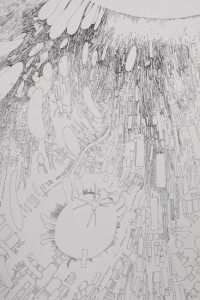
The tiny shapes layered over each other around Heliotrope’s central circle are posed in contradictory reactions, alternately fighting their way towards the blankness and trying to escape its gravitational pull. Meanwhile, at the sides of the pieces, other blank circles and amorphous shapes seem to have spawned from the fertile central orb and begun to imitate it, releasing their own tendrils and forming relations with shapes within their own immediate area. Heliotrope feels like a microscopic look at the relations between the tiny shapes in any of Keefe’s other drawings – zooming into the cracks and finding them teeming with a multitude of their own living objects.
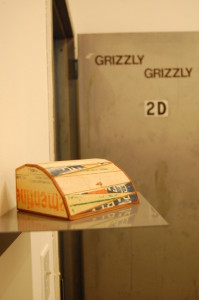
Visitors to Grizzly Grizzly may start to imagine how they would live inside the spaces they are presented with, and which ones they would prefer to inhabit. In diagramming how they react conceptually, emotionally and somatically to city spaces, the artists represented here craft a visual narrative of urban spatial relations. But in the end, some of us might be better off moving to the country.
“Urban Environments” will be up at Grizzly Grizzly through Sept. 28.


